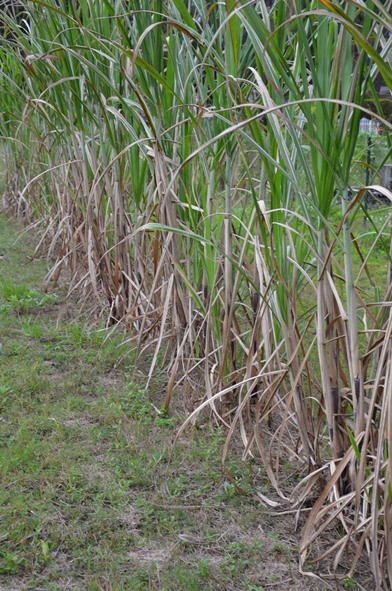
Backyard Sugarcane in the Panhandle
Do you want to add a little something different to your landscape? How about something edible, as well as a focal point in your garden? Backyard sugarcane may be just what you are looking for.
Sugarcane, genus Saccharum, is a tropical perennial grass that thrives in humid environments across the southern United States. Based on physical and chemical characteristics, there are 3 types of sugarcane. Chewing canes (Yellow Gal, Georgia Red varieties) are soft, with fibers that stick together when chewed. Many of these canes are also used for syrup production. Crystal canes, used mainly for commercial purposes, contain a high percentage of sucrose. This is the molecule that crystalizes into granular sugar. Syrup canes (Louisiana Ribbon, Green German varieties) contain less sucrose, therefore less crystallization, making for a more fluid product. Some varieties of each type are interchangeable. For example, some crystal canes are satisfactory for chewing cane.
How does one plant sugarcane? Sugarcane is propagated by “seed cane”. Mature cane stalks have nodes, about every 6 inches, that produce buds. The stalks are cut into 2-3 foot segments and then planted. After the following harvest, the sugarcane sprouts from the buds of the old stalks, through a process known as “ratooning”. Be patient when growing sugarcane. It takes approximately 12-14 months for the original planting (seed cane) to produce mature cane, while another year to produce cane from the ratoon.
Seed cane should be planted from mid-August through November. Growth will occur in the spring. Sugarcane can be planted, 4 -10 feet apart, as a single row or multiple rows. A 3-7-inch furrow depth is optimum. Common practice regarding fertilizer is to apply 1 pound of 8-8-8 fertilizer per 10 feet of furrow. Plan ahead, as this crop makes a great windbreak for your vegetable garden.
Avoid planting sugarcane in areas of high traffic. The leaves of the cane are very sharp and some sugarcane varieties can fall and obstruct areas. Well drained soils in a sunny area is the perfect environment. Times of stress, such as lower temperatures for long periods of time, poor soil fertility and pH extremes (best range 5.5-6.5) will cause lower yields. Heavy watering with poor drainage conditions of newly planted seed cane can also disrupt bud germination.
Overtime, many varieties will succumb to disease and other environmental factors. To manage sugarcane against weeds, hand weeding and mulching are the best options. Soil inhabiting worms and grubs, stalk borers, termites and aphids are the biggest threats regarding insect pests. Sugarcane is rapidly growing plant and can tolerate most insect infestations and be productive.
Sugarcane is unique as many of the heirloom varieties are still available. So, where does one find seed cane? The classified ads section of the “Market Bulletin” published by the Florida Department of Agriculture and Consumer Services is a good start:
The Panhandle provides a favorable growing environment for this delightful backyard gardening focal point plant. Contact your local county extension office for more information.
Information for this article is from the UF/IFAS EDIS publication: “Backyard Sugarcane” by L. Baucum, R.W. Rice, and L. Muralles.
UF/IFAS Extension is an Equal Opportunity Institution.


